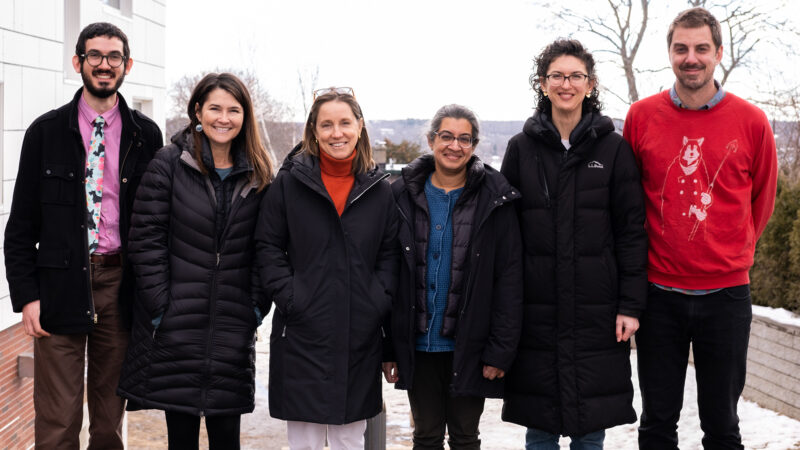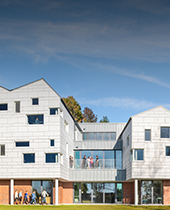Thematic studies drives new Middle School curriculum planning
Despite all its harm, the COVID-19 pandemic drove many school administrators and teachers to explore new opportunities for pedagogical innovation. At Waynflete, Middle School Director Divya Muralidhara sought out fresh ideas to make the school’s grades 6–8 program more interdisciplinary, more interconnected, and more interdependent, leading to greater cohesion during the academic year and across grades. With support from Head of School Geoff Wagg, Divya determined that this change would take the form of “thematic studies”—major themes for each of the three grade levels that would serve as the foundation for curriculum development.
After soliciting initial feedback from the entire Middle School faculty, Divya established a five-person committee in March 2022. The group comprised both new and seasoned faculty members who were passionate about the thematic studies concept and eager to think beyond their own academic disciplines. Divya granted the team significant autonomy to shape the loosely formed concept into a sequence that would enable teachers to build on the material taught in earlier grades. “I put my name in because I love this kind of synthesis thinking,” recalls Cassie Pruyn, an English teacher who served on the committee. “I was interested in the process of connecting all these different ideas.”
Following the April break, committee members worked with Divya to put the final touches on the draft themes prior to a faculty presentation in May. “I loved what I was seeing in terms of the committee’s connection,” Divya says. “They were energized as a group, and there was real value in their debates and discussions.”
A preamble to the introduction of the themes explains that they were designed “to awaken the imagination, deepen curiosity about self and community, provide space for reflection and inquiry, and broaden one’s sense of the world.” Inspired by Maslow’s hierarchy of needs, the sixth-grade theme, “Adapt, Survive, Thrive,” explores how needs have driven humans to invent and innovate, how civilizations around the world have found different ways to meet their own needs, and how the design of our bodies (and understanding of our identities) reflects adaptations to the needs of survival.
Grade 7 students broaden their outlook in their theme, “Exploring Home.” Students ask: What do home and community mean to me? How can understanding the role of community make us more empathetic to each other? How does listening to each other’s stories strengthen our community? What responsibility do we have for protecting and nurturing our planet?
Finally, in eighth grade comes the most dramatic theme of all: “Change: Destruction, Transformation, Creation.” “We thought a lot about the word ‘destruction,’” says Cassie. “We knew that it might have a negative connotation for some. But it’s an exciting word. We wanted the students to be thinking, ‘What would I do differently?’” Students spend the year exploring how they can harness forces of change to reinvent themselves and the world around them. How must we challenge the thinking of the architects of our societal structure to address profound injustices? How can our passions and leadership skills motivate us to act in the face of challenges and uncertainty? How can we effectively engage with each other to bring about change?
The themes become more abstract as students progress through the three grades, meeting them where they are developmentally and ultimately preparing them for a successful transition to the Upper School. Committee members sought to strike a difficult balance—to create a curriculum-building framework that wasn’t stiflingly specific yet not so broad as to be “mushy” (i.e., too easy to connect anything to the theme). “It would have lost some of its tension,” says Cassie. “The idea was to create openings through which someone teaching in any department or discipline could connect.”
Middle School faculty discussed the proposed themes in small groups and provided feedback to committee members. “There was a great amount of respect and appreciation” for the work of the committee members, says Divya.
As the end of the academic year approached last spring, grade-level teaching teams met in workshops to start sketching out potential changes to the curriculum that would incorporate the new themes. While complete overhauls were not expected in the first year, faculty members were asked to connect some aspects of their classroom content to the themes. Stipends were made available to some teachers who were interested in significantly revising their curricula. “Teaching feels so urgent all the time,” says Cassie. “The pause of the summer and the stipend were really valuable. I was able to plan virtually the whole first trimester.”
These programmatic changes were also intended to open up new opportunities for cross-departmental collaboration. “We need to meet the highly integrated brains of our middle schoolers with a highly integrated program, one where knowledge is not treated separately but as connected,” says Divya. This was already happening to a limited degree. English teacher Alyssa Goodrich and history teacher Hannah Walton had sought out common threads in their curricula and designed a shared theme of courageous citizenship. Science teacher Stephanie Dolan and visual arts chair Jona Rice had collaborated on an exploration of the scientific applications and artistic uses of light. The faculty wanted to push further, however. “Authentic engagement with the themes will lead to authentic interdisciplinary connection,” says Cassie.
Lisa Libby’s sixth-grade biology class already lent itself well to the theme of “Adapt, Survive, Thrive.” “It’s embedded in pretty much everything I teach in that class,” she says. All great teachers appreciate the opportunity to rethink their curricula, however, so the idea of collaboration was top of mind for Lisa as she worked over the summer. While she was designing a new unit on structural and behavioral adaptations in animals, an idea began to crystallize: What if students were asked to design an imaginary animal, out of whole cloth, based on a set of randomly assigned traits and adaptations? A call to colleague Kim Farr, a visual arts teacher, resulted in a plan for the coming school year. After the six-graders created “new” animals (and their habitats) in science class, Kim would help them extend their work into the visual arts realm. How can you demonstrate traits and behaviors through illustration? And how do you draw convincing feathers and talons?
“The themes can serve as a through line across all courses,” says John McDevitt. “This is particularly important for sixth-graders, who have a different teacher in every subject for the first time in their lives.” As seminar teacher, John occupies the unique position of being the only faculty member to instruct every middle school student over the course of an academic year on a range of developmentally appropriate topics ranging from self-awareness and self-management to social awareness, relationship skills, and responsible decision making (he also provides counsel to faculty members on advising activities). “Everyone is focused right now on how to use the themes to guide what we do in the classroom,” he says. “But we’re already having some great conversations about how we can do more to incorporate the themes into advising.”
It’s been a successful first year. History teachers are leading their classes in discussions about ancient civilizations that thrived through innovation and adaptation. Students have examined the concepts of destruction and transformation during their units on the Reconstruction era, the Jim Crow era, and the civil rights movement. Seventh-grade students have studied Indigenous peoples of the United States, learning that everyone has a sense of home, regardless of where it is. (A unit on Ukraine led to a discussion about what happens when your city or nation is taken away from you and how this could affect your sense of belonging.) English classes have explored how our essential needs catalyzed the invention of stories—what power do stories hold, and how have they changed us over the course of human history?
Eighth-grade Spanish students have discussed what it means to leave a place that has always been home and the reasons why we might be forced to leave. In PE class, students have explored how our movements influence those around us and how we can coexist in tight spaces. And while robotics classes are fundamentally about creation and transformation, thematic studies have pushed the curriculum further. Students have examined how the field has both created new possibilities and destroyed certain jobs.
As the first year of thematic studies draws to a close, Divya and the Middle School faculty will soon meet to share their successes, provide support to those who are looking for innovative ways to connect themes to the curriculum, and explore ideas for more widespread collaboration between teachers next year. “Our students will be going into Upper School with a different sensibility around knowledge and understanding than perhaps they’ve had before, because of how intentionally we’re teaching these ideas and questions,” Divya says. “There is real potential to continue this approach of essential questions informing every aspect of our teaching and our work with young people. I think that we live in a world where finding commonality is an essential part of the journey of life.”
Lisa concurs. “Making a curriculum that is cohesive and interconnected means we’re all moving toward the same goal,” she says. “That framework just makes sense to me. I’d like to think that it makes sense to the students, too.”
Pictured above: Thematic Studies Committee members David Jaffe, Nicole Wiesendanger, Heather Courtice Hart, Divya Muralidhara, Cassie Pruyn, and Nat Silverson.



